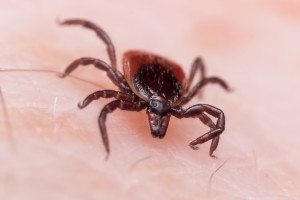Stay Safe from Ticks this Summer
 If you have a pet, you’re likely already aware of the threat of ticks, however ticks and the diseases they carry can be just as dangerous to adults and children. As we reach the peak of hot summer days this month, make sure you are familiar with the health risks associated with these tiny insects, how to avoid exposure to bites, and what to do if you find a tick on your skin or believe you’ve already been bitten.
If you have a pet, you’re likely already aware of the threat of ticks, however ticks and the diseases they carry can be just as dangerous to adults and children. As we reach the peak of hot summer days this month, make sure you are familiar with the health risks associated with these tiny insects, how to avoid exposure to bites, and what to do if you find a tick on your skin or believe you’ve already been bitten.
Ticks as Carriers of Disease
Across the United States, Western New York is among the areas most heavily populated by ticks. These small insects have been known to carry several potentially deadly diseases, including:
Lyme disease – A bacterial infection that can affect any organ of the body, including the brain, nervous system, muscles, joints, and the heart. Women infected with Lyme disease from a tick bite may pass the disease to their fetus, in rare cases, resulting in stillbirth.
Tularemia – A bacterial disease whose symptoms can range from mild to severe. Typically accompanied by a high fever, Tularemia may also cause a skin ulcer at the infection site, and swelling of regional lymph glands.
Ehrlichiosis – A bacterial infection that can cause flu-like symptoms that typically appear a week or two after a tick bite.
Babesiosis – A rare, severe, and sometimes fatal tick-borne disease caused by a microscopic parasite that infects red blood cells. Babesiosis may be transmitted from a pregnant woman to her fetus. Symptoms are not always prevalent, but may include fever, fatigue, and hemolytic anemia that lasts from days to months.
Anaplasmosis – A bacterial disease whose symptoms typically appear within one to two weeks after being bitten by an infected tick. Symptoms may include fever, headache, muscle pain, fatigue, chills, nausea/abdominal pain, cough, confusion, and rash.
Other diseases carried by ticks, not commonly found in Western New York, include:
- Rocky Mountain Spotted Fever
- Relapsing Fever
- Colorado Tick Fever
Tick Bite Signs and Symptoms
In many cases, if identification of a tick-transmitted disease is identified and treated quickly, the condition can be managed without life-threatening consequences. However, too often individuals never know that they were bitten by a tick until they experience the symptoms of one of the conditions listed above, which may not appear for a few days, or up to several weeks from the time of the bite.
Signs of a potential tick-borne illness may include:
- A red spot or rash near the location of the bite
- A full body rash
- A stiff neck
- A headache
- Muscle or joint pain
- Nausea
- Fatigue
- A fever
- Chills
- Swollen lymph nodes
What to Do if You Spot a Tick
If you find a tick on your body, it’s important to remove it quickly, but carefully. Follow these tips below for safe tick removal:
- Using pointed tweezers, grip the tick as close to the surface of the skin as possible.
- Firmly pull the tick straight upward with even pressure. Do not twist or pull too quickly, as you risk detaching the mouth parts of the tick and leaving it embedded in the skin. If this occurs, pull the mouth parts out with tweezers. If not possible, leave them to heal on their own.
- Once the tick has been removed, clean your hands and the bite area thoroughly with rubbing alcohol or soap and water.
- If the removed tick is still alive, do not squeeze it between your fingers. Dispose of it by submerging it in alcohol, or flushing it down the toilet.
Tick Bite and Infection Prevention
It typically takes over 24 hours of feeding for a tick infection to be transmitted. The sooner a tick can be safely removed, the less risk you’ll face for infection. The best way to protect yourself from a tick-transmitted illness, is to protect yourself from tick bites. Follow these tips to minimize your chances of a tick bite:
- Wear long sleeves and long pants when walking in wooded or grassy areas.
- When walking in wooded areas, stay in the center of trails and away from brush.
- Use a tick repellent that’s at least 20 percent DEET.
- After being outdoors in a tick-prone area, check your body for ticks, especially under arms, between legs, and in hair.
- Take a shower within 2 hours of being outdoors.
This summer, don’t resign yourself to staying inside and missing out on the best of the season. Enjoy the outdoors, but follow tick safety best practices and stay vigilant so that if you do identify a tick, it can be safely removed before contagion occurs. If you have any questions regarding ticks or the threats they pose, talk to your doctor.
More